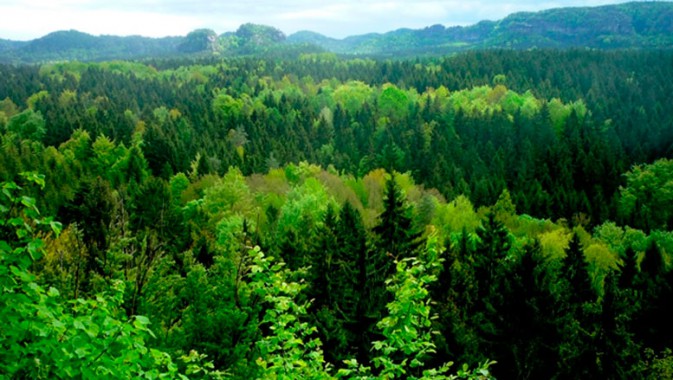




















Sunday, Mar 22, 2020 12:30 [IST]
Last Update: Sunday, Mar 22, 2020 06:51 [IST]
Ranjit Barthakur
President & Founder,
The Balipara Foundation
When we think of forests, we think of charismatic animal species: elephants, tigers, the hornbill. But we do not always connect them with people, though forests provide silent services – ecosystems services – that keep the earth running. Today, people are increasingly aware of the losses incurred with every hectare of forest lost every second, everyday: the earth’s ability to manage its water, oxygen and carbon cycles.
But forests also play an important role in preventing disease outbreaks.
THE SCIENCE OF HABITATS & HEALTH
Research by from 2015 delves into this relationship in greater detail by linking Ebola outbreaks and deforestation for palm oil plantations. Firstly, shrinking forests brought disease-bearing fruit bats into increasing contact with humans, across a broader geography than before. More victims across more villages provided more pathways for disease transmission. Secondly, the spread of palm oil plantations transformed the bats’ ordinary feeding behavior from forest-foraging to feeding and sheltering in the plantations. In turn, this increased their contact with humans, increasing overall human exposure to the Ebola pathogens carried by these bats.
Thirdly, the shrinking forests led to a decline in the overall ecosystem’s complexity and distancing – its “white noise” – which meant that infected bats were more likely to come into contact with potential carriers than otherwise. This overall rise in the speed with which pathogen carriers came into contact with potential victims led to a decline in the disease’s “burnout” – essentially preventing it from being drowned out by the overall web of checks and balances that forest ecologies provide.
LESSONS FOR INDIA’S EASTERN HIMALAYAS
The critical factor at play in the Ebola case study is the role of industrial agri-business and food production, which focuses on high volume/productivity and market profitable monoculture plantations. While oil palms had previously been planted in Guinea by forest-fringe communities, it was always on a smaller scale and through controlled, non-disruptive agroforestry. The move towards vast, industrialized monocultures eroded the finely threaded balance maintained by ecosystems, leading to the cascading changes in fruit bat populations, behaviors and distribution described above.
We see a similar pattern playing out in the North East today. The region lost approximately 765 sqkm of forests in 2019. In Assam, the rise of small tea growers alongside the tea industry’s domination of the landscape – over 3000 sqkm of its total area – has led to an increasing conversion of forests into tea plantations, as well as in Arunachal Pradesh and Nagaland. Small tea growers often practice agroforestry, but the vast estates are largely monocultures and as smaller plantations dig ever deeper into forest ecosystems, new disruptive effects may emerge – like Ebola outbreaks in West Africa – that have not yet been modelled or studied.
WHAT DO WE DO?
RESTORING HEALTHY FORESTS
The key to re-establishing the balance needed for forests to protect against pandemics is not just to create more green cover, but to restore and enhance the diversity of native forests for healthy habitats through strategic rewilding. Forest restoration, therefore, must be scientifically managed, by studying species distribution of existing forests or remaining seeds and planting local, native species accordingly. It must also be geared towards ecological connectivity, bridging fragmented forest habitats to restore environmental stochasticity. The goal for the North East in the coming years should not just be net zero deforestation, but a net increase in scientifically-restored, regenerative forest ecosystems.
BETTER INTERDISCIPLINARY RESEARCH: GEOLOGY, BOTANY, ANTHROPOLOGY
Research must be piloted regionally and must be systems-oriented and collaborative. Like the interdisciplinary OneHealth Initiative, we must understand disease risks by conducting intensive research on ecosystems, biodiversity, their intersection with human populations, with deforestation-based threat modelling to map potential outbreak hotspots.
The NaturenomicsTM principle of interdisciplinary research for securitizing LEWWAC is important: geology’s landscape focus offers long-range trends in overall environmental changes (e.g. among aquifers, land patterns etc) for health modelling, botany offers knowledge on plant-based medicines and restoring balanced ecologies, anthropology offers perspectives on forest-fringe communities’ models and understanding of health and its relationship with forests – which in turn provides new insights that might be missed by prescriptive scientific research.
DOCUMENTING TRADITIONAL & LOCAL KNOWLEDGE
MONOCULTURES TO AGROFORESTRY
The North East must look at a complete transition from industrialized monoculture plantations to agroforestry. This must be implemented not just in tea plantations, but in timber and green cover restoration programmes executed in partnership with JFMCs as well. Greater diversity, with buffer zones bridging wild and cultivated spaces will lower human to animal disease transmission. While we cannot entirely divest from commercial cultivation, a greater focus on mitigating ecological disruptions through biodiversity-rich agroforestry will improve the resilience of ecosystems.
EQUITABLE GOOD GOVERNANCE
This transition and the goal for net positive forest restoration in the North East must be encouraged through good governance. The destruction of existing forests must be taken seriously – and punished as such, with more weighted punishments for actors incurring large-scale destruction. Green cover restoration programmes must measure not just numbers, but also species diversity in plantations and their integration with local ecologies. Financial support may be needed to help tea plantations, particularly small tea growers, develop buffer zones and transitioning to agroforestry. Rigorous certification schemes will add value to tea from plantations following organic and agroforestry based cultivation – particularly as the market for ethical, eco-friendly products grows in both India and internationally.
THE FUTURE IS INTERDEPENDENT
India’s Eastern Himalayas are lucky to have almost 65% of its forests, almost more than any other region in India. As threats against these forests rise, however, the next unknown pandemic is just one more lost tree away from us. As we celebrate the International Day of Forests, let us commit to the NaturenomicsTM and Rural Futures vision for interdependency through better science, forest restoration and ecosystems protection – not just for animals, but for people.
Research support by Joanna Dawson
